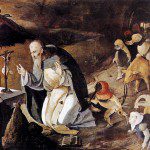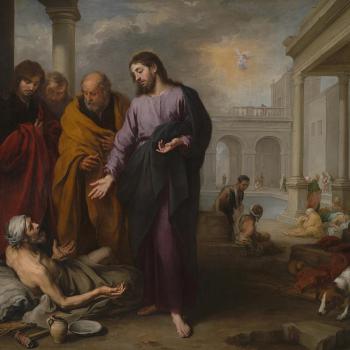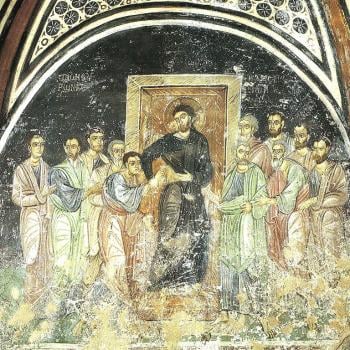This is the third post on a series exploring the eucharist. Click here for part one, and here for part two.
![Liturgy of Saint James. Russian Orthodox Church in Dusseldorf. The Gifts (Bread and Wine) prepared during the Liturgy of Preparation before the beginning of the Divine Liturgy. By Velopilger (Own work) [Public domain], via Wikimedia Commons](https://wp-media.patheos.com/blogs/sites/637/2017/07/Liturgy_St_James_1-300x225.jpg)
The Church does not deny it is bread; rather, she confirms it. But the bread which descends from heaven, and gives life to the world – the bread that Ambrose and Augustine with the same words call epiousion, that is, “super-substantial,” because the flesh of Christ exists as something greater than all other created substances; it surpasses all other creatures with the most excelling dignity. Likewise, the wine is not like any other, for it is one that gives joy to the hearts of men – not all men, but rather, only to the servants of God, for its inebriates their souls and purges them from sin. [1]
This is why it is difficult for us to discuss what it is we receive. Outwardly, the physical form of what we receive is still bread and wine. Our senses know it only as bread and wine. Empirical science will only know it to be bread and wine. As Pavel Florensky explained, the essence has changed, the reality is Christ, bringing the presence of Christ to those who receive communion, but physically, the bread and wine remain bread and wine and we can talk about them as such:
Keeping this in mind, it becomes easier to approach the question of sacraments. Externally, and even in chemical composition, the materials of the sacraments do not differ in any way from ordinary materials, although they have different essences. The Holy Gifts of the Eucharist do not differ in any way in appearance from ordinary bread and wine, but metaphysically and mystically they differ in essence; the external identity does not tell us anything. The life of the body depends on internal life; the state of the body depends on psychic state. No state of the spirit is a matter of indifference for the body.[2]
Just as God made nature, and all the processes found in nature, which allowed for the creation of bread and wine, bread and wine are able to be transformed into Christ, as Lanfranc indicated:
And just as no one should be hesitant about, nor ignorant of, the fact that bread and wine are formed by nature, so in a similar vein, no one should have any doubt about the conversion of the bread into the true body of the Lord. [3]
Bread and wine are normally converted into our body and blood when we eat and drink them. For this reason, it should not be surprising that and wine can become Christ; indeed, we should believe that they did so as he ate and drank during his ministry. He now takes the ordinary natural processes which transform bread and wine into himself and applies it to the bread and wine handed over to him at the altar. While the mode might be new, the process itself is shown to be normative to life itself. Jesus had been transforming bread and wine into himself throughout his life, but now he has used that transformative process as a way for us to receive him and the graces he has in store for those who properly receive him.
St. Irenaeus saw that what was happening to the bread and wine was also happening to us. The transformation of bread and wine into Jesus allows us to receive Jesus and have him come within us, but likewise, then, within, and then find ourselves following suit, to be transformed by our reception of Jesus within us so we can be changed, receiving the food which renders incorrupt when we experience the resurrection of the dead:
Then, again, how can they say that the flesh, which is nourished with the body of the Lord and with His blood, goes to corruption, and does not partake of life? Let them, therefore, either alter their opinion, or cease from offering the things just mentioned. But our opinion is in accordance with the Eucharist, and the Eucharist in turn establishes our opinion. For we offer to Him His own, announcing consistently the fellowship and union of the flesh and Spirit. For as the bread, which is produced from the earth, when it receives the invocation of God, is no longer common bread, but the Eucharist, consisting of two realities, earthly and heavenly; so also our bodies, when they receive the Eucharist, are no longer corruptible, having the hope of the resurrection to eternity.[4]
We receive Jesus in thanksgiving, which is why what we receive is called the eucharist (the Greek word, εὐχαριστία, means thanksgiving). Only those who come to the spiritual table in belief and thanksgiving, with the proper spiritual disposition, are called to receive. It is thanks to the invocation of the Holy Spirit through imitation of Jesus’ activity at the Last Supper we find the transformation takes place, so that we can truly have ordinary bread become our super-substantial bread from heaven.
In his “First Apology” as an answer to pagan critics of the Christian faith, St. Justin Martyr explained what it was that was received, why it was received only by believers, and gave a general declaration of how that food was rendered to us through the transformation of bread and wine into Jesus himself:
And this food is called among us Εὐχαριστία [the Eucharist], of which no one is allowed to partake but the man who believes that the things which we teach are true, and who has been washed with the washing that is for the remission of sins, and unto regeneration, and who is so living as Christ has enjoined. For not as common bread and common drink do we receive these; but in like manner as Jesus Christ our Saviour, having been made flesh by the Word of God, had both flesh and blood for our salvation, so likewise have we been taught that the food which is blessed by the prayer of His word, and from which our blood and flesh by transmutation are nourished, is the flesh and blood of that Jesus who was made flesh.[5]
Thus, there is a transmutation which takes place, and it is not done by the power of the one celebrating the eucharist, but by the authority of Jesus who is God which renders the rite successful. The celebrant allows themselves to become a vessel of Jesus Christ. There is, then, a way by which Jesus works the transformation; just as he was incarnate through Mary and the Holy Spirit, so he works through a priest and the Holy Spirit to establish the transformation of our earthly food into himself, our heavenly food. The priest is set apart by ordination, by the laying on of hands in a special form which establishes their priestly service, just as Mary was specially chosen by God, sanctified by the Holy Spirit, and made ready for receiving in her womb the incarnate Logos.
St. Ambrose made this clear with his examination of the way the eucharist is brought to us. Reflecting upon Jesus as the Word, so Jesus, in the expression of himself, in a word, has the power to make what he says come true. When he defines something to be, it becomes what he says; he speaks, and it is so:
By what words, then, is the consecration and by whose expressions? By those of the Lord Jesus. For all the rest that are said in in the preceding as said by the priest: praise to God, prayer is offered, there is a petition for the people, for kings, for the rest. When it comes to performing a venerable sacrament, then the priest uses not his own expressions, but he uses the expressions of Christ. Thus the expression of Christ performs this sacrament.[6]
It is because the priest follows Jesus, and not himself, it is not an issue of magic, an issue of control over God; the rite is successful because the priest and the community with him are Jesus and doing what Jesus said to do, with faith that Jesus would accomplish his goal because Jesus said he would. It is done to the wish of Jesus. What is impossible with us becomes possible through him: “Accept, then, how Christ’s expression was accustomed to change every creature and changes the designs of nature when he wishes.” [7]
[1] Lanfranc of Canterbury, “On the Body and Blood of the Lord” in Lanfranc of Canterbury: On the Body and Blood of the Lord and Guitmund of Aversa: On The Truth of the Body and Blood of Christ in the Eucharist. Trans. Mark G. Vaillancourt (Washington, DC: Catholic University of America Press, 2009), 47.
[2] Pavel Florensky, At the Crossroads of Science & Mysticism. Trans. Boris Jakim (Kettering, OH: Semantron Press, 2014), 45.
[3] Lanfranc of Canterbury, “On the Body and Blood of the Lord,” 49.
[4] St. Irenaeus, Against Heresies in ANF(1):486.
[5] St. Justin Martyr, “First Apology” in ANF(2):185.
[6] St. Ambrose, “The Sacraments,” in Theological and Dogmatic Works. trans. Roy J Deferrari, PhD (Washington, DC: Catholic University of America Press, 1963), 302.
[7] St. Ambrose, “The Sacraments,” 303.
Stay in touch! Like A Little Bit of Nothing on Facebook:
A Little Bit of Nothing












